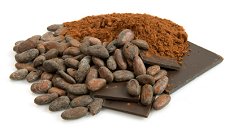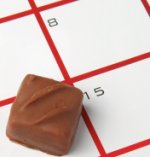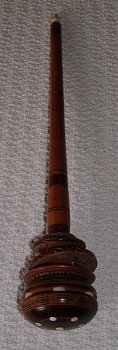Author Archive: Bryn Kirk
Avoid Mistakes While Tempering Chocolate
November 12, 2009
As a follow-up to a few recent posts about tempering chocolate, I thought it might be useful to discuss some common mistakes you might make when tempering.
The most common mistakes I see are the lack of temperature control, lack of proper stirring, not choosing the right chocolate for the job, improper storage, and letting moisture contact the chocolate.
Let’s take a closer look at each of these situations...
Read more
Devil’s Food Cake Recipe
November 5, 2009

Why is the cake called Devil’s Food?
Folk lore says that a group of Pilgrims that lived next door to a Chocolate House in Amsterdam in the late 1600’s, witnessed chocolate house patrons cavorting and making merry while they consumed chocolate. The Pilgrims were convinced that chocolate was made from the devil. They named chocolate “Devil's Food.” Later on, when dark chocolate cake gained in popularity, it was named Devil’s Food Cake for its sinfully delicious nature.
Read more
Chocolate as a Cure For Everything
November 3, 2009
Before modern science began discovering the much talked about health benefits of chocolate, the Mayans (central America) and Aztecs (ancient Mexico) considered it a powerful remedy to many ailments.
Theobroma cacao, or the “chocolate tree,” has been used in folk medicine as an anticeptic, diurectic, and parasiticide. It has been used to heal burns, cough, dry lips, fever, listlessness, malaria, nephrosis, rheumatism, snakebites, and small wounds.
Read more
Chocolate Definitions
October 29, 2009
Confusion in the world of chocolate?
You might think, "there’s nothing confusing about chocolate -- you buy it, you eat it!" The reality is, the chocolate world has its own lingo, with terms and definitions that apply to the tasting of chocolate, the baking and cooking of chocolate, and the making of chocolate confections.

Read more
American Chocolate Holidays
October 27, 2009
Today I caught myself absent-mindedly jumping from website to website (I think this is the equivalent to channel surfing) when I landed on a site dedicated to listing American holidays. What really caught my attention was the list of American FOOD Holidays. Hey, did you know that each day of the year has an assigned food to worship?
Here are some examples:
- January 16 -- National Fig Newton Day
- February 7 -- National Fettuccine Alfredo Day
- March 23 -- National Chip and Dip Day
- April 6 -- National Caramel Popcorn Day

And so on...
Read more
Experiencing Fine Chocolate
October 13, 2009
Some people compare a fine chocolate to a fine wine. I do too. How about you? If so, isn’t it about time you know what to “look for” and how to “taste” fine chocolate?
The Aroma
Smell the chocolate. Concentrate on the intensity of the aroma and the many different scents you can identify. Some of the most common scents in chocolate are vanilla, honey, milk, fruit, spice, and roasted nut.
If you have trouble smelling something, gently put your finger on the surface and melt a small bit of chocolate to release the aroma and try again.
Read more
How to Temper Chocolate (Step 2 – Finish)
October 8, 2009
When you buy chocolate in the store, it is already tempered. (At least it should be!) Basically this means it is in a stable solid form at room temperature.
If you want to get down to the business of eating the chocolate straight out of the package, no problem, just break off a chunk and go to it! But, if you want to use the chocolate for any other purpose you may have to re-temper.
This is the final part in my series of tempering chocolate. The first article was about the importance of tempering chocolate. The last article was about melting the chocolate to get ready for tempering.
Read more
Molinillo – Unique Chocolate Gift Idea
October 3, 2009
I like kitchen gadgets, baking tools, and small appliances. Sometimes I even use them! (lol). I especially love chocolate paraphernalia.

This tool was invented by the Spanish colonists in Mexico around the 1700's. The first molinillos were made to fit into a container with the handle sticking out of the top. Then the user would rapidly rotate the molinillo between his/her palms. The twisting motion frothed the chocolate.
How to Temper Chocolate (Step 1 – Melt It)
September 14, 2009
The first step in tempering chocolate is melting the chocolate... Properly!
You might be thinking, what's the big deal about melting chocolate?
Chocolate is a low melting point food. It melts just below human body temperature. While this low melting point means it’s easy to melt in the mouth, it also means it’s easy to burn when direct heat is used. Overheating chocolate will cause it to burn. Burnt chocolate is irreversibly damaged and cannot be used.
In addition to burning, another potential problem when melting chocolate is "seizing". This can happen if you use an indirect heating method like a hot water and a double boiler. Small amounts of water will cause the chocolate to “seize” or become hard and crumbly. Seized chocolate is irreversibly damaged and cannot be used.
Godiva Chocoiste – Milk Chocolate Whole Cashews
September 4, 2009
Godiva has a line of chocolates that, according to their website, are more decadent and more portable. They call it ChocoisteTM.
I recently tried their Milk Chocolate Whole Cashews and I must say I enjoyed them very much! My  chocolate preference is dark, but I do enjoy a milk once in a while. The reason I enjoyed this particular milk chocolate and cashew combination is the way the milk chocolate pulls out the bold, buttery, and salty flavor notes from the nuts and enhances them.
chocolate preference is dark, but I do enjoy a milk once in a while. The reason I enjoyed this particular milk chocolate and cashew combination is the way the milk chocolate pulls out the bold, buttery, and salty flavor notes from the nuts and enhances them.
Read more

